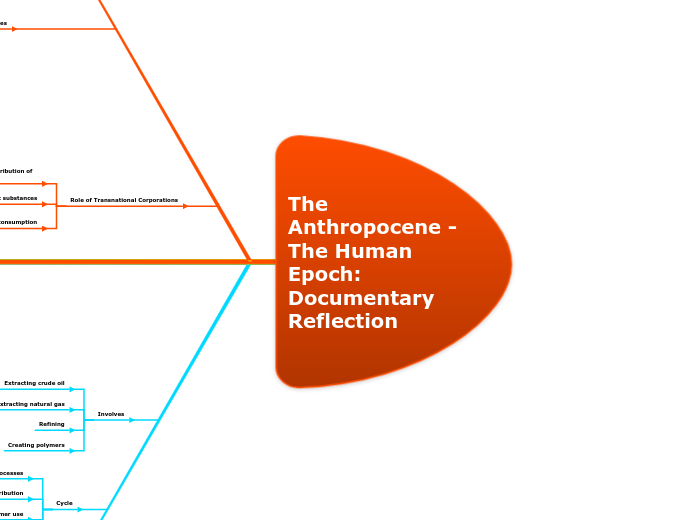The Anthropocene - The Human Epoch: Documentary Reflection
Consequences
Infrastructure changes
Informal settlements in urban expansion
Role of highways
Population challenges
Struggles in accommodating growing populations and the need for sustainable urban development
Urban Planning
Population Growth
Environmental changes
Seawalls
Habitat loss
Decline in biodiversity due to urban development and land reclamation
Urban sprawl
Land-use transformation
Large-scale growth
Movement of people
Involves the expansion of cities and suburbs into rural and natural lands
India's struggle with informal settlements
China's megacity growth
Los Angeles' historical development
Human Response and Activism
Urgent need for changes in industry practices and individual behaviors to combat climate change
Sixth mass extinction is attributed to human activity and pollution
The World Wildlife Fund reported a significant decline in population for half of all animal species since 1970
Climate Change Effects on Lagos, Nigeria
Wealth disparity and informal settlements increase vulnerability to flooding
The city's layout of islands and peninsulas exacerbates the impact of natural coastal processes
A high-risk city due to coastal erosion intensified by climate change
Underwater Impact
Coral Bleaching
Australia is a major coal exporter
Faces tensions between conservation and industry
In 2016, The Great Barrier Reef suffered a mass bleaching event
Lost around 22% of its corals
Linked to rising sea temperatures and increasing ocean acidity
Historical CO2 Levels and Warming Predictions
Estimated climate warming of 3.2 to 5.4°C above pre-industrial levels by 2100
In 2013, CO2 levels reached 400 ppm for the first time on record
Throughout much of Earth's history, CO2 levels ranged between 200 ppm and 280 ppm
Industrial Revolution and Carbon Emissions
Corporate Knowledge and Responsibility
Companies operating along coastlines are aware of the physical damage and pollution their activities cause
Major fossil fuel companies have known for decades that their products contribute to global warming
Emissions result from cement production and burning of fossil fuels
Release of over 390 billion tonnes of anthropogenic carbon emissions into the air
Until a more efficient energy source is found, global sustainability takes a back seat
Anthroturbation
Global Infrastructure and Engineering
Development
Quarries
Mines
Extensive tunnels
Anthropogenic transformation of landscapes
Impact on Urban Areas
Technological advancements leaving a definitive record of human presence
Indications of human influence on Earth's geology
Scarring the planet and transforming the underworld
Proof of human ability to change the Earth
Florida phosphate mining
Growing Underground in London
The Gotthard Base Tunnel
Berezniki's extensive underground tunnels
Sinkholes
Involves large-scale activities under the Earth by humans
Human activities transform both the Earth's surface and subsurface
Mining
Drilling
Human tunnelling
Technofossils
The technosphere is a significant component
Technofossils and the Technosphere
Physical components of human systems and technologies
Estimated weight of the technosphere
Resistance to decay
Anthropocene and the Technosphere
Contribution of human-made objects as indicators of a new epoch
Composed of human-made materials
Human-generated objects are technofossils
Global significance
Long-lasting impact
Rapid increase in production
Aluminum
Role as an indicator of human activity
Unique properties
Significance in future geological records
Coating the Earth
Extensive use
They serve as geological markers and indicators of human impact on the environment
Plastics in the Solid Waste Stream
Carbon Footprint Awareness
Understanding personal waste production and its impact on the biosphere
Decomposition of Plastic
Environmental dispersion of microplastics
Extended decomposition time
Waste Production and Recycling Rates
Canadians produce significant waste
Large portion ending up in landfills
Global Plastic Waste Management
Exporting plastic waste to other countries and its negative outcomes
Impact on waste management
Low recycling rates
High production
Environmental Impact of Landfills
Improper disposal of plastics can lead to environmental harm
Poses challenges in recycling
Environmental pollution
Contribution to greenhouse gas emissions
Methane gas release
Importing and Exporting Plastics
Consumer Education and Empowerment
Empowering individuals to make informed choices and reduce waste
The need for informed consumer choices and responsible waste management practices
Environmental Impact of Plastic Export
Negative outcomes in recipient countries
Lack of infrastructure
Pollution
Global Plastic Waste Trade
Capacity and Funding Challenges
Developing countries struggling to handle the waste from developed nations
Becoming a growing concern
Exporting plastic waste from developed to developing countries
Root Causes of Waste Production
Poor attitudes leading to excess waste
Treating other countries as dumping grounds
Lack of education
Misconceptions about recycling
Life Cycle of Plastics
Questions about the necessity of single-use plastic items
Growing concern and inquiries about plastic consumption and its impact
Waste Generation and Disposal
Recycling is not perfect
Recycled plastic loses quality and durability over successive cycles
Landfill issues
Environmental Impact of Production
Pollution from the production process
Greenhouse gas emissions
Resource Consumption
Inordinate amounts of natural resources required for plastic production
Cycle
Disposal
Consumer use
Distribution
Bottling processes
Creating polymers
Refining
Extracting natural gas
Extracting crude oil
Extinction
Ecosystem Loss and Smaller Species Decline
Habitat disruption due to human activities
Ecosystem loss affects various organisms, not just large mammals
Fish
Birds
Insects
Rapid Decline in Animal Species
Extinction of species
Northern White Rhinoceros
Near-extinction of diverse rhinoceros species due to human activities
Illegal poaching
Threats to elephants and rhinoceroses leading to population decline
Elephant Poaching
Illegal Ivory Trade
Significant decline in animal populations due to human activity
Mass Extinction in the Anthropocene
The Anthropocene is marked by a sixth mass extinction caused by human activities
Terraforming
Scientific Study of the Anthropocene
Human-induced changes in landscapes contribute to the Anthropocene epoch
Charting human influence on Earth through various markers
Importance of terraforming as a key marker
Global Impact of Terraforming
Importance of human-induced environmental change
Scale
Examples
Land scars from mining
Population growth impact
Rapid population growth in Nigeria
Creation of toxic garbage
Toxic garbage in the Dandora landfill
Tree cutting
Deforestation in British Columbia
Involves
Urbanization
Industrialization
Reshaping land for agriculture
Golden Spikes
Human Impact on Earth
Potential shift to the Anthropocene epoch
Human presence in the Holocene epoch
Scientific Decision-Making
Dominant signals and golden spikes
Ratification of time periods by academic committees
Epochs and Anthropocene Debate
Current debate on the beginning of a new epoch
Multiple potential golden spikes marking significant events
Identification of significant global events
Technofossils serve as markers of human influence on Earth
Concrete
Plastics
Geological time scale
Golden spikes indicate specific points
The Anthropocene epoch is debated due to multiple potential golden spikes
Marks significant events
Official timeline of Earth's history
Plastics and Society
Impact on Human and Animal Health
Implications on the environment
Implications of plastic waste on health
Overconsumption and limited recycling leading to a crisis
Crisis prompts efforts to reduce single-use plastics
Public Awareness and Activism
Shift in consumer and corporate behaviour towards sustainable practices
Government and Corporate Responses
Educational programs
Plastic-free materials
Sustainable alternatives
Initiatives to reduce single-use plastics
Restrictions
Bans
Public awareness and frustration drive a potential revolution against single-use plastics
Possibility of eliminating single-use plastics from daily lives
History of Plastic
Evolution of Production Techniques
Surged in the 1960s leading to environmental concerns and recycling initiatives
Innovation and Alternatives
Introduction of bioplastics as a sustainable alternative to traditional plastics
Environmental Activism
Campaigns against overconsumption and improper waste disposal
Lead to mass production and variety of plastics
Cultural and Societal Impact
Environmental consequences
Mass production
Integration of plastics into everyday life
Evolved from early semi-synthetic plastics to entirely synthetic ones
Polystyrene
Polyester
Nylon
Polyethylene
PVC
Cellophane
Bakelite
Plastic Waste Types and Recycling
Human Health Concerns
Potential exposure to toxic chemicals from non-recyclable plastics
Environmental Impact of Plastics
Slow decomposition of plastics
Recycling and disposal are essential due to this
Non-recyclable plastics contributing to environmental pollution
Leads to long-term impact
Waste Management and Recycling
Global Issue of Over-consumption
Increased production and disposal of non-recyclable plastics
Variation in plastic recycling practices in different communities
Mechanical reasons
Economic reasons
Plastics are derived from polymers sourced from natural materials
Salt
Cellulose
Natural gas
Coal
Crude oil
Different plastics are identified by resin identification codes
Resin ID codes range from 1 to 7
Bioaccumulation
Role of Transnational Corporations
Over-consumption
Excessive production of plastics and chemicals
Global trade impact on the spread of toxic substances
TNCs contributing to the production and distribution of toxins
Environmental Issues
Improper disposal leading to environmental contamination
Climate Change
Feedback loops with the release of stored toxins
Influence on the distribution of toxins and pollutants
Biomagnification
Consequences of Biomagnification
Intensifies the concentration of substances as they move up the food chain
Impact on food webs
Risks for humans consuming organisms higher in the food chain
Bioaccumulated substances can move through the food chain, with higher trophic levels experiencing greater concentrations
Ecosystem imbalances
Impact on ecosystems
Health issues
Reproductive problems
Presence of bioaccumulative substances in aquatic environments
Impact on aquatic life
Gradual buildup of substances in living organisms over time
Persistent organic pollutants (POPs)
Industrial chemicals
Certain pesticides
Occurs when an organism absorbs a substance at a rate greater than it eliminates or metabolizes it
Typically pollutants or toxins









